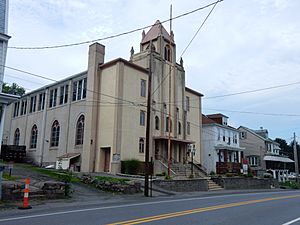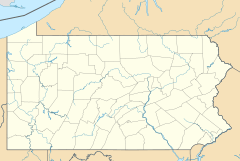Cumbola, Pennsylvania facts for kids
Quick facts for kids
Cumbola, Pennsylvania
|
|
|---|---|

Market Street (U.S. Route 209) in Cumbola. New Life In Christ Ministries.
|
|
| Country | United States |
| State | Pennsylvania |
| County | Schuylkill |
| Area | |
| • Total | 0.40 sq mi (1.03 km2) |
| • Land | 0.40 sq mi (1.03 km2) |
| • Water | 0.00 sq mi (0.00 km2) |
| Population
(2020)
|
|
| • Total | 371 |
| • Density | 932.16/sq mi (360.05/km2) |
| Time zone | UTC-5 (Eastern (EST)) |
| • Summer (DST) | UTC-4 (EDT) |
| ZIP code |
17930
|
| Area code(s) | 570 |
| FIPS code | 42-17680 |
Cumbola is a small community in Pennsylvania, United States. It is known as a census-designated place, which means it's a special area defined for gathering population data. Cumbola is located in Schuylkill County, within Blythe Township.
This community sits between two other towns, New Philadelphia and Port Carbon. You can find Cumbola right along U.S. Route 209, a main road that runs through the area. According to the 2020 United States Census, about 371 people live in Cumbola.
Contents
Where is Cumbola located?
Cumbola is in the eastern part of Pennsylvania. It's part of Schuylkill County, an area known for its history in coal mining. The community is nestled in a region with rolling hills and valleys.
The nearby U.S. Route 209 helps connect Cumbola to other places. This road is important for travel and trade in the region.
What is a census-designated place?
A census-designated place, or CDP, is not an official town or city. Instead, it is an area that the United States Census Bureau defines. They do this to collect and share population data. It helps us understand how many people live in specific areas.
CDPs do not have their own local government. They are usually part of a larger township, like Cumbola is part of Blythe Township.
How many people live in Cumbola?
The population of Cumbola changes over time. In the 2020 United States Census, 371 people called Cumbola home. This number helps us see how the community has grown or changed.
Understanding population numbers is important. It helps local planners make decisions for the community.
Images for kids
See also
 In Spanish: Cumbola para niños
In Spanish: Cumbola para niños




